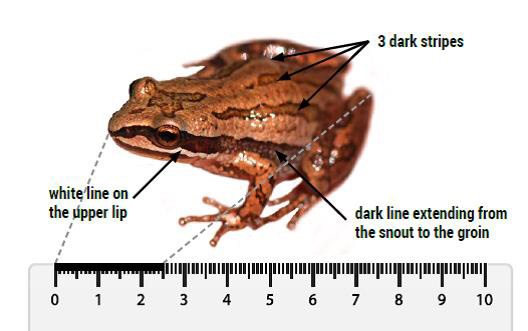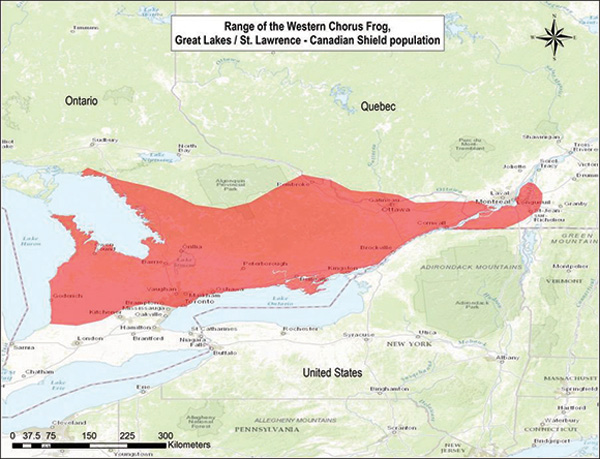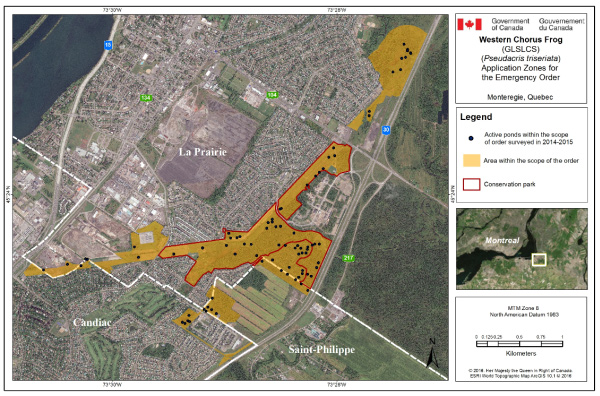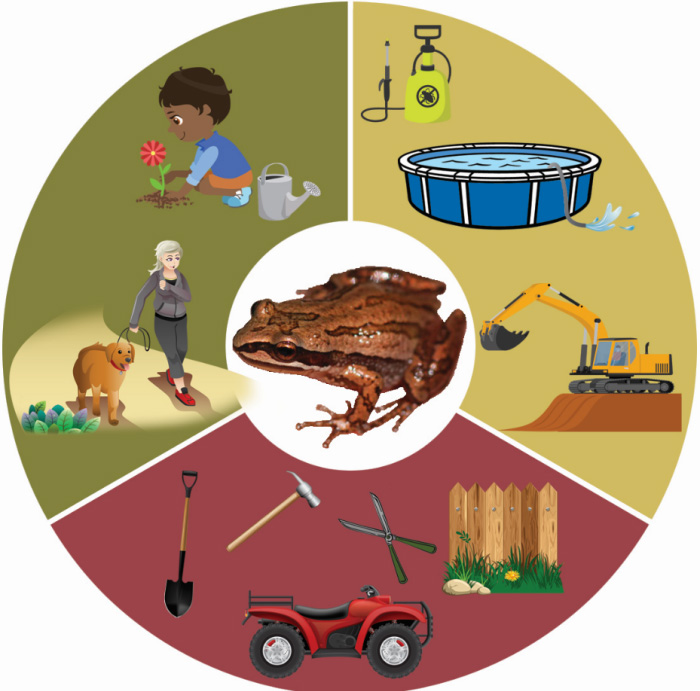Western chorus frog (specific populations): understanding the emergency protection order
Understanding the Emergency Order
Western Chorus Frog
This brochure provides information about the Western Chorus Frog, Great Lakes / St. Lawrence – Canadian Shield (GLSLCS) population, a species at risk in Canada, as well as about the measures that Environment and Climate Change Canada is taking to protect this species. This brochure is also part of the efforts being made to help affected individuals and organizations understand the Emergency Order and the impact it will have on their activities.
An order is a regulatory text that is made by the Governor in Council and has force of law.
How To Recognize The Species
The Western Chorus Frog is a small amphibian that measures approximately 2.5 cm as an adult. It varies in colour from brown to olive gray and can be recognized by the three dark, sometimes broken, stripes on its back. A white stripe runs along the upper lip, and a dark stripe runs from the snout to the groin. In the spring, during the breeding period, which can extend from early March to mid-May, the Western Chorus Frog can be distinguished primarily by the male's call, which is similar to the sound made by a fingernail running along the teeth of a comb. At other times, the species goes unnoticed.
Western Chorus Frogs reach maturity at the end of the summer and breed the following spring. They rarely live more than one year.
If you see or hear a Western Chorus Frog, you are encouraged to inform the Centre de données sur le patrimoine naturel du Québec (in French only). By doing so, you will add to our knowledge of the species and make it possible to more effectively plan its conservation.

Photo: Western Chorus Frog © Frontier Digital Art, 2016
Long description for Figure 1
Diagram showing a Western Chorus Frog with its principal characteristics used for identification. Information pop-ups point to the different characteristics: the three dark stripes on its back, the pale stripe along the upper lip, and the dark stripe running from the snout to the groin. A ruler completes the diagram showing the length of 2.5 cm.
Where Is The Species Found
In Canada, the Western Chorus Frog occurs in southern Ontario and in the Montérégie and Outaouais regions of Quebec. The species is divided into two populations. The Carolinian population, which is located in southwestern Ontario, is not at risk. The Great Lakes / St. Lawrence – Canadian Shield (GLSLCS) population comprises individuals from the other regions of Ontario and from Quebec. In 2010, this second population was listed as threatened on Schedule 1 of the Species at Risk Act.
For definitions of the status designations for species at risk in Canada, visit the SARA & You section of the Species at Risk Public Registry.

Source: Environment and Climate Change Canada
Long description for Figure 2
The map shows southern Ontario, South-western Quebec and part of the United-States. An area identifies the Western Chorus Frog, Great Lakes / St. Lawrence – Canadian Shield population range. This area starts at its western point situated mid-way between Sarnia and Goderich, follows the shore of Lake Huron heading North all the way to a point facing Sudbury then turns to the East until North of Pembroke passing through the Algonquin Park. The area keeps going East encompassing the region of Gatineau all the way to Western Montreal before it follows the south shore of St. Lawrence River until mid-way between Longueuil and Sorel. The area then goes down to the South-East drawing a curve that includes St-Jean-sur-Richelieu and continues along the American border until Toronto where it heads to Brampton, passes North of Kitchener and reaches the starting point.
The Western Chorus Frog occurs primarily in terrestrial habitats, such as woodlands, fallow lands, meadows and pastures, although it prefers shallow temporary ponds for breeding. The tadpoles develop in these ponds for close to two months. When they are developed enough to leave the water, juveniles head for the surrounding terrestrial environment. The Western Chorus Frog avoids permanent ponds that have high densities of predators, such as larger amphibians and fish. In the winter, the species hibernates on land, under rocks, logs or leaf litter, in burrows, or buried in the soil.
Western Chorus Frogs rarely stray far from their breeding ponds. Each wetland and the surrounding terrestrial area therefore delineates a local population. A metapopulation is a group of local populations between which individuals move. These movements ensure the genetic diversity of the local populations. In addition, individuals will sometimes leave the area and colonize new habitats nearby. The presence of areas favourable to movements of the Western Chorus Frog (GLSLCS) between local populations and other appropriate habitats is therefore critical to the survival and recovery of the species. When movement habitat between ponds is destroyed, isolated local populations may remain, but they are at higher risk of disappearing.
How To Protect The Species
Western Chorus Frog (GLSLCS) populations have undergone serious declines in both Quebec and Ontario. Habitat loss and degradation are the main threats to the species. In Quebec, in the Montérégie region, a decrease of over 90% in the species' historical range had occurred by 2009, while in the Outaouais, over 30% of occupied sites have disappeared since 1993. Habitat destruction in suburban areas of southwestern Quebec is happening so quickly that populations may disappear from those areas by 2030. In these regions, the main threats to Western Chorus Frog habitat is rapid residential and industrial development and agricultural intensification, such as the conversion of pasture land to grain crops. In agricultural areas, many breeding sites are also at risk of being contaminated by pesticides or fertilizers.
The range of a species is the geographic area within which a species can be found and which includes all living populations of the species (Wikipedia).
The Western Chorus Frog is also very sensitive to changes in surface water, caused either by land drainage or by the conversion of temporary ponds to permanent ponds. These changes may be due, among other things, to development in areas surrounding breeding sites, to beaver dams or to climate change.
You can play an important role in the conservation of the species to help prevent it from becoming extirpated from Canada. If you wish to take part in conservation activities, contact conservation groups in your region to find out whether such activities exist and offer to help.
Environment and Climate Change Canada or a conservation group in your region may offer to work with you to protect the species or its habitat on your property. Your participation in these protection efforts can make a big difference. By helping species at risk and their habitat, you are supporting biodiversity, which in return provides you with many services, such as purification of air and water, flood control and beautiful natural landscapes. Think about it!
The Species At Risk Act
The Species at Risk Act was passed to complement the existing federal, provincial and territorial laws on the protection of plant and animal species and their habitats. The purpose of the Act is to prevent Canadian indigenous species from becoming extirpated or extinct and to provide for the recovery of extirpated, endangered or threatened species. It also provides a framework for the management of species of special concern to prevent them from becoming threatened or endangered.

Photo: Western Chorus Frog © Jean François Déry, 2016
Long description for Figure 3
Photography showing a Western Chorus Frog in the water with its vocal sac inflated and surrounded by small branches.
Legal Protection For The Western Chorus Frog (GLSLCS)
Under the Species at Risk Act, it is prohibited to kill, harm, harass, capture or take a Western Chorus Frog (GLSLCS) individual on federal lands. The term "individual" covers eggs, tadpoles, juveniles and adults. It is also prohibited to possess, collect, buy, sell or trade an individual of this species or any part or derivative of such an individual. Lastly, the Act prohibits damaging or destroying the residence of an individual of the species, including its egg-laying and hibernation sites. On non-federal lands, the Government of Canada can make an order if it believes that the species or its residence is not effectively protected by provincial laws.
Ensuring The Survival Or Recovery Of The Western Chorus Frog
Under the Species at Risk Act, a recovery strategy for the Western Chorus Frog (GLSLCS) was published in the Species at Risk Public Registry in December 2015. The document sets out the measures required to halt or reverse the species’ decline and identifies the population and distribution objectives for the species. The strategy also partially identifies the critical habitat and presents the broad strategies and general approaches for meeting the objectives. In addition, the strategy presents a schedule of studies necessary to complete the identification of critical habitat, which is currently considered insufficient to meet the objectives.
Critical habitat is the habitat that is necessary for the survival or recovery of a species at risk and that is identified as the species' critical habitat in a recovery strategy or in an action plan for the species.
The identification of critical habitat of the species is based on two criteria: habitat occupancy and habitat suitability. It includes wetlands used for breeding in the past, as well as adjacent terrestrial habitats and movement corridors between them. A total of 267 critical habitat units have been identified, with 218 in Ontario and 49 in Quebec. The Government of Canada must now ensure that appropriate measures are taken to protect this critical habitat, including voluntary conservation measures. To that end, it will collaborate with provincial governments and consult landowners and other affected persons or organizations, including other federal departments.
Habitat suitability refers to the biophysical characteristics of habitat within which individuals can meet their various life-cycle needs.
In addition, one or more action plans will be developed to define and guide implementation of the recovery strategy and to complete the identification of critical habitat.
To learn more about what is being done to protect species at risk in Canada or to read the recovery strategy for the species, visit the Species at Risk Public Registry.
Emergency Order Made To Protect The Species
Under the Species at Risk Act, an emergency order may be made if there is an imminent threat to the survival or recovery of a species at risk. In December 2015, the Minister of Environment determined that the Western Chorus Frog (GLSLCS) was facing an imminent threat to its recovery in La Prairie, Quebec due to a housing development. Following this statement, the Minister was required to make a recommendation to the Governor in Council, who decided to make an emergency order to protect the species in this area. The Order, which describes the area that is covered by the Order and the provisions prohibiting activities that are likely to harm the species and its habitat, is posted on the Species at Risk Public Registry and summarized below.
Geographic Area
The Schedule of the Emergency Order describes the area to which it applies. This area is included in the municipalities of La Prairie, Saint-Philippe and Candiac, Quebec, as shown on the following map.

Source: :Environment and Climate Change Canada
Long Description for Figure 4
Map showing the municipalities of La Prairie, Saint-Philippe and Candiac in Quebec. A colored zone shows the area to which the Order applies. Dots show active ponds included in the area to which the Order applies and recorded in 2014-2015. A line delineates the future conservation park of Smitter's marsh. To obtain the legal description of the area to which the Order applies, please refer to the Order Schedule.
This map illustrates the area to which the Emergency Order for the Protection of the Western Chorus Frog (Great Lakes / St. Lawrence – Canadian Shield population) applies. It is provided for information only and must not be used for legal interpretation or implementation purposes. If there is any contradiction between the information in the present document and the Emergency Order mentioned above, the Order takes precedence. For a legal description of the area to which the Emergency Order applies, please consult the schedule of the Emergency Order in the Canada Gazette, Part II, or in the Species at Risk Public Registry.
Prohibitions
The prohibitions are intended to prevent the loss or degradation of the habitat that is required for the recovery of the Western Chorus Frog (GLSLCS) and to prevent activities that could harm the species. In the areas described in the Emergency Order, the following activities are prohibited:
- Remove, compact or plow the soil;
- Remove, prune, damage, destroy or introduce any vegetation, such as trees, shrubs or other plants;
- Drain or flood the ground;
- Alter surface water in any manner, including by altering its flow rate, its volume or the direction of its flow;
- Install or construct, or perform any maintenance work on, any infrastructure;
- Operate a motor vehicle, an all-terrain vehicle or a snowmobile anywhere other than on a road or paved path;
- Install or construct any structure or barrier that impedes the species’ circulation, dispersal or migration;
- Deposit, discharge, dump or immerse any material or substance, including snow, gravel, sand, soil, construction material, greywater or swimming pool water; and
- Use or apply a pest control product as defined in section 2 of the Pest Control Products Act or a fertilizer as defined in section 2 of the Fertilizers Act.
Furthermore, certain activities carried on outside the area covered by the Emergency Order are also prohibited if they contravene the prohibitions set out in the Order. An example of such an activity would be work that involves draining or flooding the ground outside the area of application but results in the alteration of surface water within the area covered by the Order.
Penalties For Offences
Any contravention of a prohibition of an emergency order is an offence under the Species at Risk Act. A person who is convicted of an indictable offence is liable to a fine of up to $250,000 and/or imprisonment for up to five years, or to both. On summary conviction, the person would be liable to a lower fine of up to $50,000 and imprisonment for up to one year, or to both. Any corporation other than a non-profit corporation that contravenes a provision of the Emergency Order is liable to a fine of up to $1,000,000 if found guilty of an indictable offence or a fine of $300,000 if convicted of an offence punishable on summary conviction. Any non-profit corporation that contravenes a provision of the Emergency Order is liable to a fine of up to $250,000 if found guilty of an indictable offence or a fine of $50,000 if convicted of an offence punishable on summary conviction.
If Environment and Climate Change Canada enforcement officers can show that an offence has taken place, they have a legal obligation to enforce the law and use their discretionary power to choose the most appropriate response, which may range from a warning to legal prosecution.
To obtain a copy of the Emergency Order (including its Schedule) and to find out whether your property falls within the area covered by the Order, please refer to the Canada Gazette, Part II, or the Species at Risk Public Registry.
To report a possible contravention, contact Environment and Climate Change Canada's Enforcement Branch by email or by phone at 1-800-668-6767.
Frequently Asked Questions
- Why is the protection of this species important?
- Canada's natural heritage is an integral part of our national identity and history. Wildlife has value in and of itself and is valued by Canadians for aesthetic, cultural, spiritual, recreational, historical, economic, ecological and scientific reasons. Protecting each and every species supports biodiversity, which in return provides us with many services, such as purification of air and water, flood control, control of biting insects, and beautiful natural landscapes.
- Does the Emergency Order apply to private land?
- Yes. The Order applies to all land, whether privately owned or not, described in the Schedule of the Order.
- How long is the Emergency Order valid?
- The Order is valid indefinitely. Only the Governor in Council can decide to modify or repeal it. If the Minister of Environment is of the opinion that the species would no longer face imminent threats to its recovery if the Order were repealed, she is required to recommend its repeal to the Governor in Council.
- Are there plans to make other Emergency Orders for the protection of this species?
- No, not for the time being. Under the Species at Risk Act, the Government of Canada can make various orders to protect the species, its residence or its critical habitat on non-federal lands. However, the Government of Canada prefers to use efficient voluntary conservation measures.
- Does the Emergency Order apply in case of an emergency for public health and security matters?
- No. Activities necessary for protecting public health or public safety that are authorized pursuant to provincial legislation are exempt from the Emergency Order. This could include, for example, work by Hydro Québec in cases of emergency, and municipal work on blocked culverts and watercourses that is required to prevent flooding. Activities necessary for protecting public health or public safety that are authorized pursuant to federal legislation are also exempt under certain conditions.
- Can I continue to use the Smitter's Marsh conservation park?
- Yes. The developed areas and marked trails in the conservation park remain open to the public, particularly for walking and cross-country skiing, as long as visitors do not engage in activities prohibited by the Order. Visitors must also comply with any other applicable regulations, including those of the park.
If I Own Land That Is Covered By The Order
- Can I carry out construction work on my land?
- No. The Order prohibits any new construction, even if it has already been authorized by the province or the municipality.
- Do I need a permit from the Government of Canada to carry out work on my land?
- The Order prohibits any form of maintenance of infrastructure such as buildings, fences or paths. The Order also prohibits removing, pruning, damaging, destroying or introducing any vegetation. For more information about the permits required, visit SARA Permits and Agreements.
- Can I walk anywhere on my property?
- You can walk in the area covered by the Order, as long as you do not contravene the prohibitions regarding soil, vegetation or water flow.
- Can I drive a motor vehicle anywhere on my property?
- In the entire area covered by the Order, it is prohibited to drive a motor vehicle (including ATVs and snowmobiles) anywhere but on roads and paved paths.
- Can I be compensated following the adoption of the Order?
- No. When it decided to make an emergency order, the Government of Canada made no plans to pay compensation.
- Can I sell my property?
- Yes. You are still the owner of your land, and you can sell it.
- Can I obtain financial assistance to take action to help conserve the species?
- There are several forms of financial assistance if you want to take action to help conserve the species. Since most of the funding is allocated to conservation groups, you can also contact the groups in your region to find out whether they are engaged in this type of activity and offer them your help.
If I Own A Land Adjacent To The Area Covered By The Order
- Can I carry out maintenance on my land?
- Yes. You can carry out regular maintenance on your land, including seasonal clean-ups, as long as your activities do not contravene the Order - for example, by releasing greywater or dumping waste that could affect the area covered by the Order. Be extremely careful when emptying your pool, when watering after applying pesticides or fertilizers, and during snow removal. Runoff from these activities may alter the flow or quality of surface water and harm the Western Chorus Frog.
- Do I need a permit from the Government of Canada to carry out work on my land?
- Check to make sure. Large projects, such as constructing buildings, paving over land or digging in soil, even if they are located outside the area covered by the Order, may affect Western Chorus Frog habitat in the area covered by the Order. This type of work can, for example, alter the direction of water flow by making surfaces impermeable or changing drainage patterns. Depending on the location of your land, especially if it is near the area covered by the Order, your construction projects may contravene the Order. To find out what permits are required, visit SARA Permits and Agreements.
Poster

Long Description for Figure 5
Diagram showing a circle divided in three portions. Illustrations appear in each portion and a Western Chorus Frog appears in the middle of the circle.
The first portion, presenting the permitted activities, shows a drawing of someone gardening and another drawing showing a person walking along a path with a dog on a leash.
The second portion of the diagram, presenting the potentially risky activities, shows drawings of pesticides, a swimming pool being emptied (backwash) and a backhoe digging in earth.
Finally, the third portion, presenting the prohibited activities, shows a garden spade, shears, a hammer, an all-terrain vehicle and a wooden fence in a yard.
Permitted Activities
- Continue to enjoy the full use of your property outside the area covered by the Order.
- Use Smitter's Marsh conservation park, by staying within the developed areas and on the marked trails. This park is part of the area covered by the Order.
Potentially Risky Activities
Activities that are prohibited within the area covered by the Order may also be prohibited outside that area, if they affect it. For example, take precautions when you
- Use or apply fertilizers or pest control products.
- Deposit, discharge, dump or immerse any material or substance (e.g. snow, sand and swimming pool water).
- Perform work that could alter surface water (e.g. drainage and flooding).
Good maintenance practices outside the Order's area of application are not affected.
Prohibited Activities
In the area covered by the Order, the following activities are prohibited:
- Removing, compacting or plowing the soil.
- Removing, pruning, damaging, destroying or introducing any vegetation.
- Installing, constructing, or performing any maintenance work on any infrastructure.
- Operating a motor vehicle (including an ATV or a snowmobile) anywhere other than on a road or paved path.
- Installing or constructing any structure or barrier that impedes the movement of the Western Chorus Frog.
In some specific cases, it may be possible to obtain a permit authorizing prohibited activities. Check for more information.